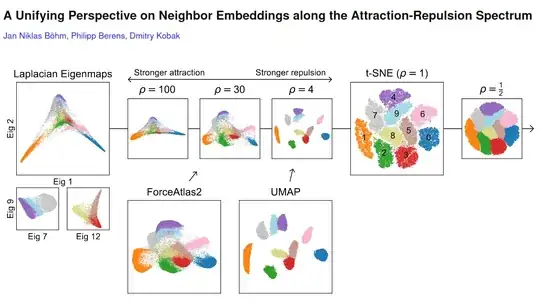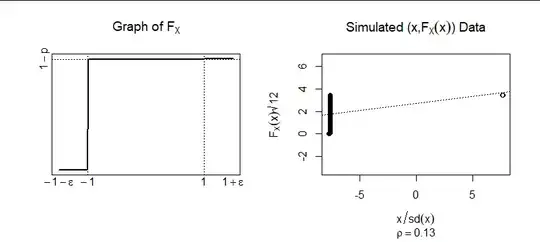Are there known bounds on the $\operatorname{cor}(X,F(X))$? $X$ is a random variable with CDF $F(X)$. Let $X$ have a fixed variance, for example $\operatorname{var}(X)=1$. What $X$ can maximize or minimize the covariance?
-
Related answer: https://math.stackexchange.com/q/2555218/14893 – Xi'an Mar 02 '22 at 13:03
-
1Consider a uniform variable supported on the interval $[-\sqrt{3}, \sqrt{3}]$ and then consider a Rademacher variable. – whuber Mar 02 '22 at 16:42
-
@whuber Thanks I see that for a uniform the correlation is perfect. For a rademacher $X$ I get $cor(X,F(X))=E(XF(X))/\sqrt{12}=1/2*1/\sqrt(12)$, and $cov(X,F(X))=1/2$. Are you suggesting this is a lower bound? Why? Is this a lower bound for any data related by a strictly monotone transformation? – sayda Mar 02 '22 at 23:00
-
The bound can be made lower by modifying the Rademacher example a tiny bit. I have given the details in an answer. – whuber Mar 03 '22 at 01:08
-
@Xi'an Sorry: the original asked about *correlation* and I screwed that up in an edit. You're correct about the covariance of course, but that version of the question is uninteresting because the covariance cannot be negative and by rescaling $X,$ any positive value can be achieved. – whuber Mar 03 '22 at 13:39
2 Answers
If we assume $\mathbb E^F[X]=0$ then \begin{align} \mathbb E^F[XF(X)]&= \frac{1}{2}\int F(x)\{1-F(x)\}\,\text dx \end{align}
Indeed, assuming the pdf $f$ is associated with the cdf $F$, \begin{align} \mathbb E^F[XF(X)]&= \int x F(x) f(x)\text dx\\ &= \int_{-\infty}^0 x F(x) f(x)\text dx + \int_0^\infty x \{F(x) -1+1\}f(x)\text dx \\ &= \int_{-\infty}^0 x F(x) f(x)\text dx - \int_0^\infty x \{1-F(x) \}f(x)\text dx+ \int_0^\infty x f(x)\text dx\\ &= -\frac{1}{2}\int_{-\infty}^0 F(x)^2\text dx - \frac{1}{2} \int_0^\infty \{1-F(x) \}^2\text dx+ \int_0^\infty \{1-F(x)\}\text dx\\ \end{align} by integrations by parts. And, since $\mathbb E^F[X]=0$ then $$\int_0^\infty \{1-F(x)\}\text dx=\int_{ -\infty} ^0 F(x)\text dx$$ Note also that the variance of $X$, $\sigma^2$, does not impact the correlation since $$\text{corr}(X,F_\sigma(X))=12\dfrac{\mathbb E_\sigma(XF_\sigma(X))}{\text{var}_\sigma(X)}=12\dfrac{\mathbb E_\sigma(\sigma^{-1}XF_1(\sigma^{-1}X))}{\text{var}_\sigma(\sigma^{-1}X)}=12\mathbb E_1(XF_1(X))$$ Another identity of possible interest is \begin{align} \mathbb E^F[XF(X)]&= \frac{1}{2}\mathbb E^F[\max\{X_1,X_2\}] \end{align} when $X_1,X_2$ are iid $F$ with mean $0$
- 90,397
- 9
- 157
- 575
-
1Excellent idea. It would be nice to complete it, though, by using your result to obtain explicit numerical bounds. I have found it a little simpler to integrate the covariance $E[X(F(X)-1/2)]$ by parts directly (using $F$ instead of $1-F$). Bounds on the correlation require considering the ratio of this to the standard deviation of $X.$ – whuber Mar 03 '22 at 01:13
When $X$ has a uniform distribution on the interval $[-\sqrt{3},\sqrt{3}]$ it has unit variance and its distribution function on this interval is
$$F_X(x) = \frac{1}{2\sqrt{3}}(\sqrt{3}+x),$$
whence it has a density on this interval equal to
$$f_X(x) = F_X^\prime(x) = \frac{1}{2\sqrt{3}}$$
and zero everywhere else. Since $E[X]=0,$ the covariance is just the expected product
$$\operatorname{Cov}(X, F_X(X)) = E[XF_X(X)] = \int_{-\sqrt{3}}^{\sqrt{3}} x \frac{\sqrt{3}+x}{2\sqrt{3}}\,\frac{\mathrm{d}x}{2\sqrt{3}} = \frac{1}{2}.$$
Because $X$ is a continuous random variable, $F_X(X)$ has a uniform distribution on $[0,1],$ whence its variance is $1/12.$ The correlation therefore is
$$\operatorname{Cor}(X, F_X(X)) = \frac{\operatorname{Cov}(X, F_X(X))}{\sqrt{\operatorname{Var}(X)\operatorname{Var}(F_X(X))}} = 1.$$
Thus, this universal upper bound can be attained.
Let $\epsilon$ be a (tiny) positive number and consider now any continuous variable $X$ with support on $[-1-\epsilon,-1]\cup[1,1+\epsilon].$ Suppose $\Pr(X \le 0) = 1-p$ and (therefore) $\Pr(X \gt 0) = p.$ Let's compute the correlation by finding the relevant moments.
In the right hand plot, both variables have been standardized to unit variance: their correlation coefficient is the slope of the least squares line shown. Here, $p=1/2.$
Clearly $F_X(x)=0$ for $x \lt -1-\epsilon,$ rises continuously to a value of $1-p$ at $x=-1,$ is level at that value for $-1\lt x \lt 1,$ and then rises continuously to $1$ by the time $x$ reaches $1+\epsilon.$ Again, since $X$ is a continuous random variable, $F_X(X)$ is a uniform random variable on $[0,1].$ Also, since $X$ is closely approximated by a binary random variable $Y$ with $\Pr(Y=1)=p$ and $\Pr(Y=-1)=-p,$ their variances will be close and $\operatorname{Var}(Y)=4p(1-p).$
The covariance is a little trickier. Compute
$$\operatorname{Cov}(X, F_X(X)) = E[X(F_X-1/2)] = \int_{-1-\epsilon}^{-1} x (F_X(x)-1/2)f_X(x)\,\mathrm{d}x + \int_1^{1+\epsilon} x (F_X(x)-1/2)f_X(x)\,\mathrm{d}x.$$
Integrate these by parts by splitting the integrands into $x$ and all the rest. The result is $p(1-p) + O(\epsilon).$ Consequently
$$\operatorname{Cor}(X, F_X(X)) = \frac{p(1-p)/2 + O(\epsilon)} {\sqrt{4p(1-p)+O(\epsilon)}\sqrt{1/12}} = \sqrt{3p(1-p)/4} + O(\epsilon).$$
This can be made as close to $0$ as we might like by making $p$ close to either $0$ or $1$ and shrinking $\epsilon.$ Consequently, any lower bound on the correlation cannot be positive.
Most of the density of $X$ has been pushed up against $\pm 1$ by shrinking $\epsilon.$ Now $p=1/200.$ The correlation has reduced from $0.87$ in the first figure to $0.13$ here.
Finally, since $F_X$ is a non-decreasing function, the correlation of $X$ with $F_X$ cannot be negative. Coupled with the preceding observation we conclude
Universal bounds for the correlation of $(X, F_X(X))$ are $0$ and $1.$ These are the best possible.
In fact, $0$ cannot be attained. (The intuitively obvious case would be to take the limits as $p\to 0$ and $\epsilon\to 0^+$ in the second example, but this reduces $X$ to a constant, where the correlation is undefined.)
- 281,159
- 54
- 637
- 1,101
-
1The integration by parts in the second example (for the lower bound) is essentially the same thing done by Xi`an in another answer to this thread. – whuber Mar 03 '22 at 01:13
-
1It's a bit of a surprise, isn't it? That's why questions and answers like these are fun. – whuber Mar 03 '22 at 23:52

